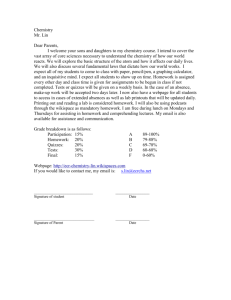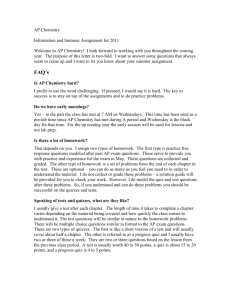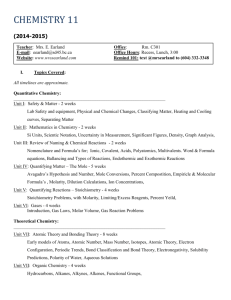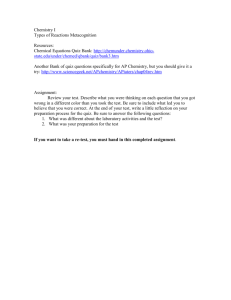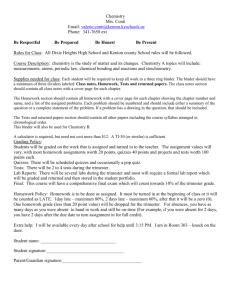Chemistry I Course Outline
advertisement
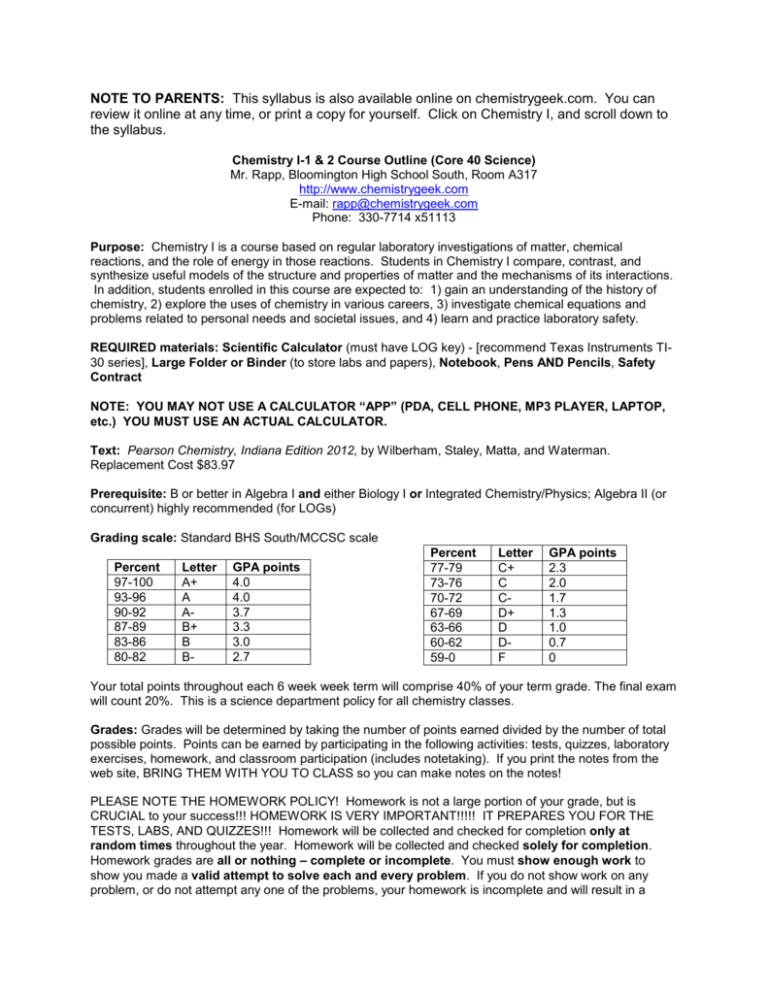
NOTE TO PARENTS: This syllabus is also available online on chemistrygeek.com. You can review it online at any time, or print a copy for yourself. Click on Chemistry I, and scroll down to the syllabus. Chemistry I-1 & 2 Course Outline (Core 40 Science) Mr. Rapp, Bloomington High School South, Room A317 http://www.chemistrygeek.com E-mail: rapp@chemistrygeek.com Phone: 330-7714 x51113 Purpose: Chemistry I is a course based on regular laboratory investigations of matter, chemical reactions, and the role of energy in those reactions. Students in Chemistry I compare, contrast, and synthesize useful models of the structure and properties of matter and the mechanisms of its interactions. In addition, students enrolled in this course are expected to: 1) gain an understanding of the history of chemistry, 2) explore the uses of chemistry in various careers, 3) investigate chemical equations and problems related to personal needs and societal issues, and 4) learn and practice laboratory safety. REQUIRED materials: Scientific Calculator (must have LOG key) - [recommend Texas Instruments TI30 series], Large Folder or Binder (to store labs and papers), Notebook, Pens AND Pencils, Safety Contract NOTE: YOU MAY NOT USE A CALCULATOR “APP” (PDA, CELL PHONE, MP3 PLAYER, LAPTOP, etc.) YOU MUST USE AN ACTUAL CALCULATOR. Text: Pearson Chemistry, Indiana Edition 2012, by Wilberham, Staley, Matta, and Waterman. Replacement Cost $83.97 Prerequisite: B or better in Algebra I and either Biology I or Integrated Chemistry/Physics; Algebra II (or concurrent) highly recommended (for LOGs) Grading scale: Standard BHS South/MCCSC scale Percent 97-100 93-96 90-92 87-89 83-86 80-82 Letter A+ A AB+ B B- GPA points 4.0 4.0 3.7 3.3 3.0 2.7 Percent 77-79 73-76 70-72 67-69 63-66 60-62 59-0 Letter C+ C CD+ D DF GPA points 2.3 2.0 1.7 1.3 1.0 0.7 0 Your total points throughout each 6 week week term will comprise 40% of your term grade. The final exam will count 20%. This is a science department policy for all chemistry classes. Grades: Grades will be determined by taking the number of points earned divided by the number of total possible points. Points can be earned by participating in the following activities: tests, quizzes, laboratory exercises, homework, and classroom participation (includes notetaking). If you print the notes from the web site, BRING THEM WITH YOU TO CLASS so you can make notes on the notes! PLEASE NOTE THE HOMEWORK POLICY! Homework is not a large portion of your grade, but is CRUCIAL to your success!!! HOMEWORK IS VERY IMPORTANT!!!!! IT PREPARES YOU FOR THE TESTS, LABS, AND QUIZZES!!! Homework will be collected and checked for completion only at random times throughout the year. Homework will be collected and checked solely for completion. Homework grades are all or nothing – complete or incomplete. You must show enough work to show you made a valid attempt to solve each and every problem. If you do not show work on any problem, or do not attempt any one of the problems, your homework is incomplete and will result in a grade of zero. If work is shown on each problem, your grade will result in a score of 5 out of 5 points. At the college level, homework often does not count for any points! This policy is designed to help transition you to the college level, and gain more self-discipline. Some homework assignments will be CALCULATOR CHECKS. If you bring your calculator to class, you will receive full credit for the homework grade. Participation grades will be judged solely by the teacher and will be determined upon the following factors: behavior, attitude, attendance, note-taking, completing assignments on time, and volunteering to put problems on the board or answer questions. The opinion of the teacher on participation points in FINAL. This is used primarily if you are on the border between two letter grades at the end of a term. There are no extra credit assignments. This is a science department policy for all chemistry classes. You must check your grade weekly on the web site using your BHSS web grades password. Class time will not be spent checking grades. If you do not have access at home, you can use a school or library computer. Classroom Rules: (follow these to keep Mr. Rapp happy and award participation points!!) 1. Bring materials to class. You should bring your text and planner daily, along with your calculator and materials to take notes. Do NOT bring food or drink, as part of this room is a working laboratory. 2. If you are going to be/have been absent, it is YOUR responsibility to see me about a make-up assignment. Please do this at the end of the class period. This is also on the web site http://chemistrygeek.com. For tests, homework, and quizzes, you have as many days to turn the assignment as you were absent. YOU MAY NOT WAIT UNTIL THE NEXT SRT PERIOD. Late work is accepted at a 50% reduction for each 0-24 hours past the due date and time. PACE may be assigned for those who do not complete the homework on a regular basis. For labs ONLY, you may choose to have an extension until the next SRT period, or one week whichever comes first. Absolutely no labs can be made up after one week has passed from the day we finished doing the lab in class (unless the student is absent continuously for more than one week). 3. Do your homework - the only way to succeed is to practice! Class time is for working, not playing. Chemistry assignments come first. Should you complete your chemistry assignment, then you may work on something else. Wasting time (playing cards, etc.) will not be tolerated. 4. Do not talk while someone else (especially Mr. Rapp) is talking. Please raise your hand if you have a question and I will call on you as soon as I am at a stopping point. 5. While attendance is taken, get your materials ready to take notes. Be ready to start as soon as I am finished! If you do so, you may talk QUIETLY until attendance is completed. Please be on time. You are considered tardy if you enter the doorway after the bell rings. 6. Follow all instructions, especially in the laboratory. Dress appropriately for lab. (see safety contract) 7. All school rules will be enforced. Cheating on any test or assignment will result in a zero score. Cell phones are not to be on or out at any point during any class time. Yes, this means that having it on silent is NOT good enough! If your parents need you in case of emergency, they should call the office at 330-7714, or text/call your cell phone during lunch or between classes. iPod/mp3/music players are only allowed during work time. They are not to be out during instructional time, lab time, or test time. You may use them after exam time, if the volume is low enough so that you do not disturb anyone else in the room. 8. Please do not leave the room unless it is absolutely necessary. You MUST have a hall pass. Leaving the room without permission, unless in an emergency situation, will result in a referral. Be sure to ask for the hall pass so I know where you are going. 9. All jokes made by the teacher, no matter how stupid they are, must be tolerated. Please ask questions! Laboratory Rules: see safety contract - YOU MUST WEAR GLASSES OR GOGGLES IN THE LAB AT ALL TIMES! Points may be deducted for not following this STATE AND FEDERAL LAW! Lab safety will be discussed prior to the first lab session. Your safety contract MUST be on file before working in the lab. Schedule of Topics: First Trimester Measurement & Matter (Chapters 1 and 2) Nuclear Chemistry (Chapter 25) Modern Atomic Theory (quantum, electron configs) (Chapters 4 & 5) Periodic Table (Chapter 6) Nomenclature (Chapter 9) Schedule of Topics: Second Trimester Bonding (Chapters 7 & 8) Reactions (without redox) (Chapter 11) Stoichiometry, including gas stoich (with integrated dimensional analysis and unit conversions) (Chapter 12, part of Chapter 14) Gases (Chapter 14) Solutions (Chapter 16) Acids & Bases (Chapter 19) Redox or Equilibrium (if time permits) (Chapter 21 or 18) Periodic Table A laminated copy of a periodic table will be provided for all exams. This is the same table that you received with this syllabus. The periodic table for the nomenclature unit ONLY (first unit of second trimester) will be the same table, but will NOT include the full name of the elements, nor will it include the polyatomic ions on the back. You are not expected to memorize the entire periodic table (although some high schools do!). Polyatomic Ion List You are required to know the polyatomic ions (and variations on those ions) as listed in the Chemistry I polyatomic ion list. Element List You are required to know the names and element symbols for common elements, as listed in the Chemistry I element symbol list. Yes, correct spelling is expected. Labs The following labs will be completed in all Chemistry I classes at minimum: 1. Flame Tests 2. Mass-Mass Stoichiometry and Limiting Reactant (gravimetric) 3. Acid-Base titration Quizzes (all Chemistry I classes) 1st trimester Week 1: Element symbol quiz Quiz will cover ALL elements and symbols on the attached blue sheet Quizzes will be worth 12 points, and contain 6 questions 3 questions will give the name and ask for the symbol 3 symbols will be given and ask for the name Three minute time limit Week 2: Students will be given a quiz on the names of common laboratory equipment (from the handout), worth 10 points Week 3: Polyatomic ion quiz Quiz will cover ALL the polyatomic ions on the blue sheet Quizzes will be worth 12 points, and contain 6 questions 3 questions will give the name and ask for the formula and charge 3 questions will give the formula and charge and ask for the name Three minute time limit Every OTHER week after week 3: Element symbol & Polyatomic Ion quizzes Quiz will cover a mixture of the element symbols AND polyatomic ions on the blue sheet Quizzes will be worth 12 points, and contain 6 questions Same format as the quizzes from week 1 and 3 Three minute time limit 2nd trimester A nomenclature quiz will be given every OTHER week Quiz will cover ionic, covalent, and acid nomenclature Quizzes will be worth 12 points, and contain 6 questions 3 questions will give the name and ask for the formula 3 questions will give the formula and ask for the name Five minute time limit Revised 8/15/10


